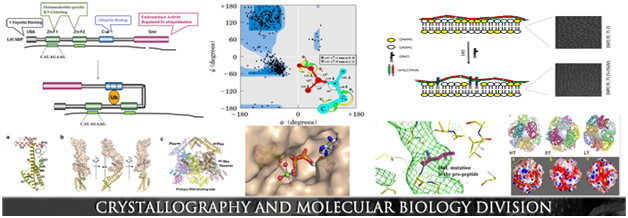
The major goals of the Division are to understand the key biological processes using tools of X-ray crystallography, spectroscopy, cellular and molecular biology. 3D structures of various proteins like Psu from bacteriophage P4, involves in transcription termination in bacteria and thermostable mutant of pro-papain were determined. Psu exists as a knotted homodimer and is first of its kind in nature. Detailed structural elucidation of protease pro-papain explained the stepwise autocatalytic activation mechanism by limited proteolysis of the zymogen of papain. Cloning, expression, purification, crystallization and preliminary X-ray analysis of a fructokinase and two low-molecular-weight protein tyrosine phosphatases from Vibrio cholerae O395 have been reported. It has been shown that expression of recombinant human cathepsin K is increased by codon optimization. Computational algorithm has been developed to explain protein-protein interactions based on the electrostatic complementarity and surface (or shape) complementarity of interior residues. It was confirmed by site-directed mutagenesis that RXL-like cyclin-binding (Cy) motif dependent interaction of LdHAT1 with LdCyc1 is essential for its phosphorylation at a canonical Cdk target site by the kinase complex. Phosphorylation of LdHAT1 by the S-phase kinase inhibits its H4K10 acetylation activity, implicating a mechanism of periodic regulation of histone acetylation during cell cycle progression. The effect of post-translation modification on the activity of the homologous proteins in mammals during cell cycle progression is being studied. The regulation of gene expression at posttranscriptional level is also a major area of our research. Thirty six interacting partners of HYPK was identified. Various experimental and computation analysis of the interacting partners of HYPK reveal that HYPK together with its interacting partners involve in several biological processes like protein folding, response to unfolded protein, cell cycle regulation, apoptosis and regulation of transcription. Analysis of the validated targets of altered miRNAs in Huntington’s disease reveals that they might be involved in apoptosis, differentiation and development, fatty acid, cholesterol, lipid, glucose, and carbohydrate metabolism, cell cycle and growth and transcription regulation. Besides, micro RNA 125b has been shown to involve in cell cycle regulation by targeting MDA1 protein. Clinical proteomics and lipidomics studies of various blood components from patients suffering from hemoglobin disorders e.g. thalassemia & sickle cell disease are underway. Spectroscopic, biochemical and biophysical studies of erythroid and non-erythroid spectrin with reference to hydrophobic ligand binding, lipid-protein interactions and chaperone activities are being done.